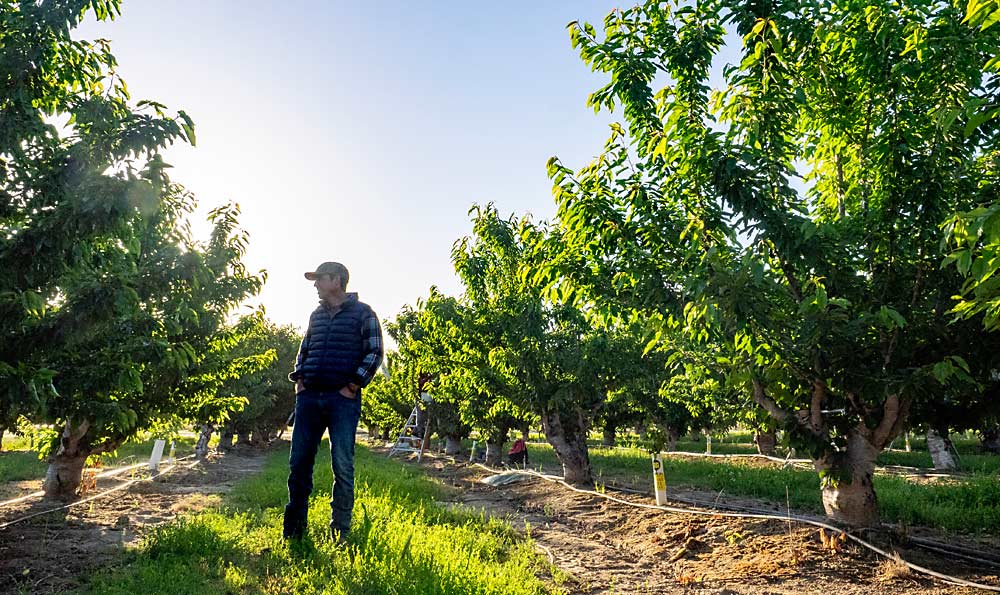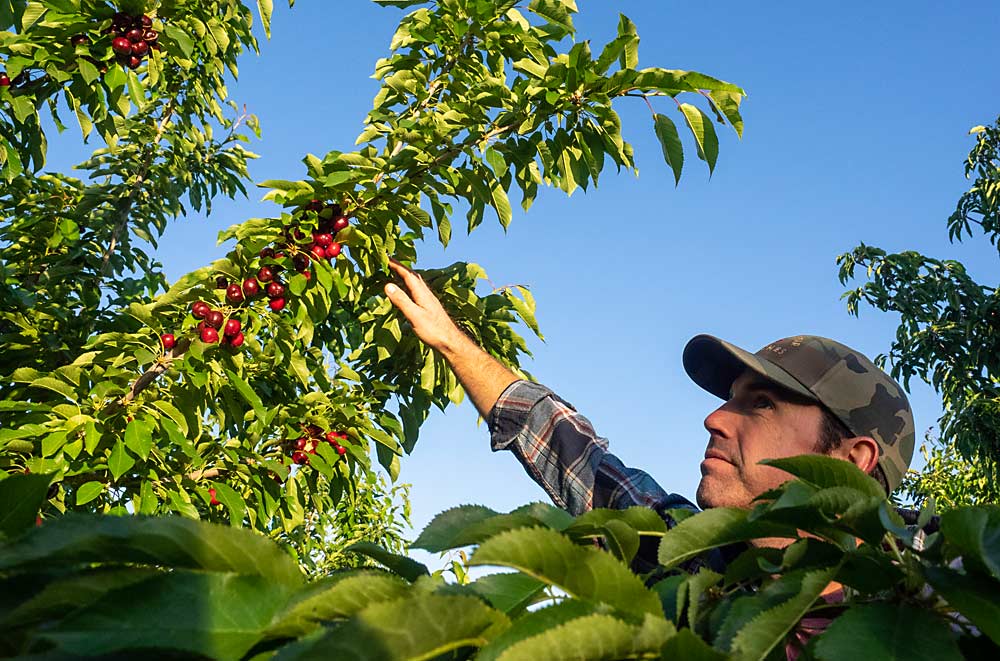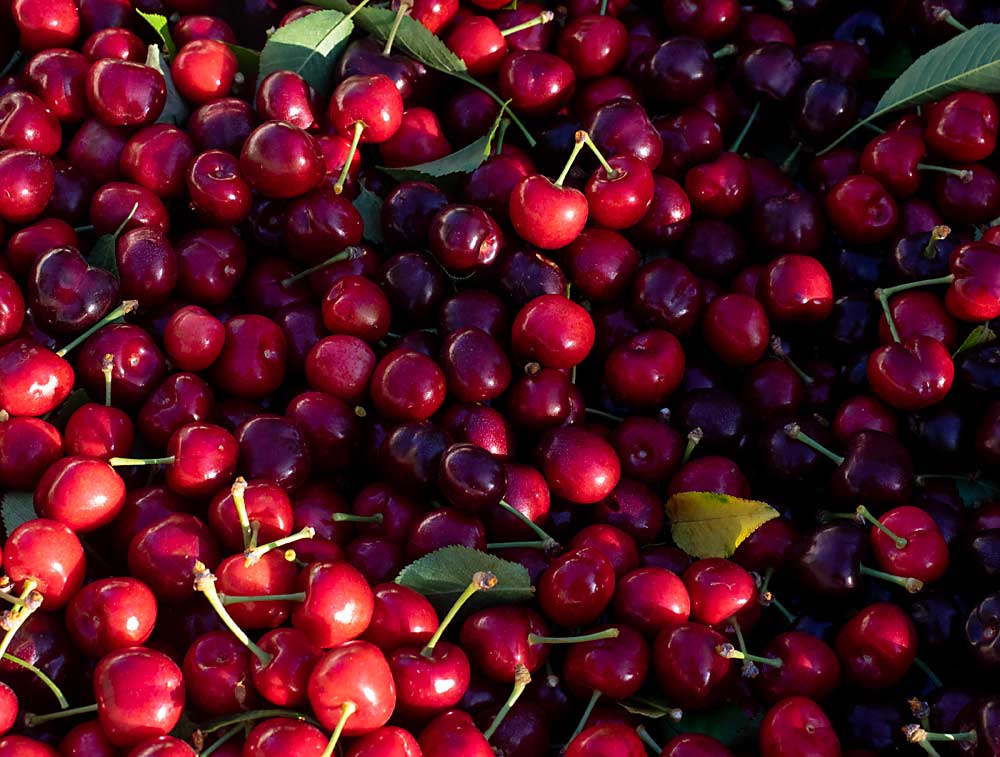
Cherries can be grown profitably in California’s Central Valley, despite its warm winters, thanks to dormancy-breaking agents such as Dormex and CAN-17. But they must be sprayed at the right time, and in recent years — especially with weird new weather patterns driven by climate change — some growers are finding that the dynamic chill-portion model isn’t working as well as it used to.
“Either you don’t have the chill — or you think you have the chill, but the trees didn’t feel it the same way,” said Giulia Marino, an extension specialist in crop systems at the University of California, Davis. With funding from the California Cherry Board, she leads research to help growers find ways to adapt to warmer winters, fine-tuning spray timing and the chill model itself. The research enters its third year this spring.
“It’s horrible. We’re having a hell of a time,” said Joe Cataldo, a Lodi, California, grower who also heads the field relations department for Lodi-based Delta Packing Co. He ran through a litany of recent weird weather — hot spells, less fog, less rain, rain at odd times — and summed up the consequences: The quantity has been “somewhat normal,” but fruit quality has suffered.
“We’ve had some good years on paper, but the quality of our dormancy has been inconsistent,” said Cataldo, who serves on the cherry board’s research committee. He described the UC Davis work as “very crucial.”
“It needs to be figured out right away,” he said.
His cherries are depending on it.

Measuring the big chill
The chill-portion model is based on air temperature, which is a proxy for the temperature the trees are feeling. But how good a proxy? Marino’s team strapped thermocouples to trees and installed weather stations at two commercial orchards over the past two winters to measure the differences, hoping to improve the model. The sites are at opposite ends of the San Joaquin Valley, near Linden and Bakersfield, and typically get around 80 and 70 chill portions, respectively.
On foggy days, they found air and bark temperatures were about equal. But on dry, sunny days, air temperature was 25 or 30 degrees Fahrenheit lower than the bark temperature. The driver was solar radiation, which warmed up the trees while evaporating ground moisture.
Marino said that was in line with what growers were saying: They were no longer seeing as many foggy days.
Deeper analysis showed another nuance in the data after a big rain event, suggesting that the wet bark had cooled via evaporation. Marino and her colleagues surmise that adding solar radiation and humidity to the chill model will more accurately predict tree temperatures, and therefore the amount of accumulated cold.
“If you have enough chill, you don’t have to worry about this,” she said. But when the chill is low, and you have to spray, “then you have to be as precise as possible.”
Precision dormancy-breaking
Dormancy-breaking agents even out the bloom, they get pollenizers and orchard trees to bloom together, and they help growers get a jump on the harvest before all the Washington cherries are ripe, Cataldo said.
But deciding when to spray is tricky. The chill-portion model gives a 7- to 10-day window. Then growers depend on intuition — built on years of experience with their microclimate — and (ideally) a major dollop of luck.
“It depends on the forecast for the window, too,” said John Gibson of Golden Bear Ranches, another Lodi grower. “Sometimes you want to go later, but it’s calling for a downpour, and you just have to roll with it …. More precision is extremely valuable.”
Fifty or 75 hours less chill “could be ‘make or break’ (between) having a 200-box set per acre or a 350-box set per acre,” he said.

Marino’s team wants to help reduce the guesswork by unfolding the longstanding scientific mystery of what is happening inside a sleeping cherry tree, so growers can wake it up when it is ready.
“We still don’t know very well, from a physiological point of view, what dormancy is,” Marino said. “There are a lot of questions still open as to how trees are able to understand that winter is passing.”
All winter long, a leafless tree appears unchanging on the outside. Physiologically, there’s a lot going on inside.
“Carbohydrates are changing, as a function of change in the temperature felt by the tree,” Marino said.
The work her team is doing builds upon basic research by Maciej Zwieniecki at the UC Davis Carbohydrate Observatory, where studies are revealing how starches, sugars and water content rise and fall during each stage of dormancy. (Quick biology refresher: Sugar is energy, and starches are chains of sugars — essentially energy storage. Sugars can be converted into starch, and vice versa, according to what the tree needs.)
From five test plots in the two orchards, researchers collect cherry twigs all winter to grind up and analyze at the carb lab. Near the end of dormancy, they drape huge bags over control trees to keep the dormancy-breaking sprays off them.
“For a week in February, all I do is throw bags over trees — with a whole lot of help,” said Kari Arnold, a collaborator on the project. “It’s always a race against time.”
Test plots at each orchard were chosen to help researchers isolate the effects of genotype-specific chill requirements, which chemical treatment was used, and location. The varieties are Brooks and Coral, grown on both Mahaleb and Mazzard rootstocks. Growers are using Dormex (hydrogen cyanamide) or CAN-17 (calcium ammonium nitrate) as dormancy-breaking agents.
Preliminary results from the project’s first winter showed “some neat changes in the dynamic of carbohydrates that are associated with the progress of winter,” Marino said. But the research is in progress.
“We’re still characterizing this, and we need multiple years, because each year is different,” Marino said. “We hope to build a solid relationship between the accumulation of cold and changes in carbohydrates, and use this information to apply dormancy-breaking agents based on this predicted or measured carb status, and see what is the best moment to apply.”
They’re also looking for physiological indicators that will tell growers the right time to spray — which could be biomarkers analyzed in a lab or something more macro, like trunk shrinkage, Nelson said.
Having another metric to reduce dependency on the chill model would help. “But even if we have to rely on the chill model, at least the model will be improved,” Arnold said.
Scientists have previously studied changes in carbohydrates over dormancy at a small scale or in potted samples. It’s unusual for this kind of basic research — such as figuring out how trees work — to be funded in this applied setting, Arnold said.
“These very basic scientific foundational things that we don’t know could aid us massively in the future of agriculture,” she said.
The “pie-in-the-sky hope,” Arnold said, is that research like this could eventually help screen for lower-chill varieties. Currently, estimates of varieties’ chill needs are in fact just estimates. “That would be absolutely incredible,” she said, “but we’re not there yet.”
Gibson sees the research as part of a slew of approaches growers are taking to climate adaptation, whether it’s ripping out Bings and replacing them with low-chill varieties such as Corals, adding canopy irrigation or applying sun protectants.
“I know we can get through it,” he said. “It’s all about finding the right techniques to get through those low-chill years.”
—by Kate Golden






Clearly neasuring bud temperarure rather than air shade temperature is a much better way to use for evaluating chilling accumulation. But under espesially warm winters another factor can affect productivity and that is the specific negative effect of heat spell on flower bud developnent , leading to abnornal developnent and to production of abnormal flowers that will not set. This effect is independent of chiling accumulation .